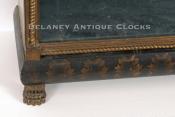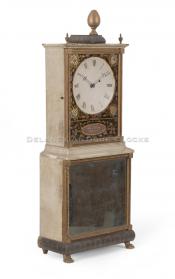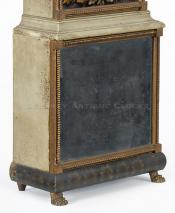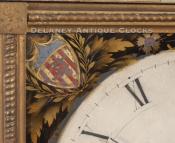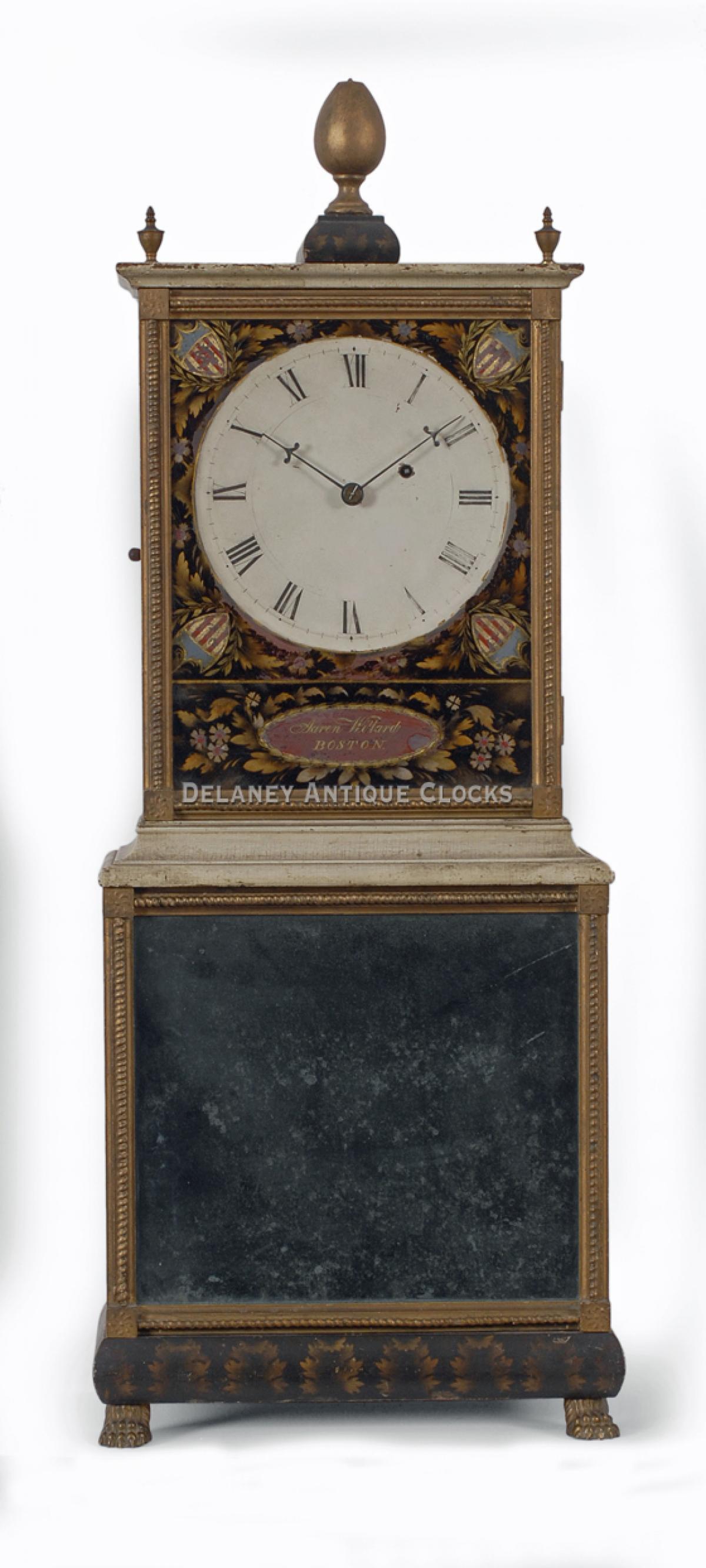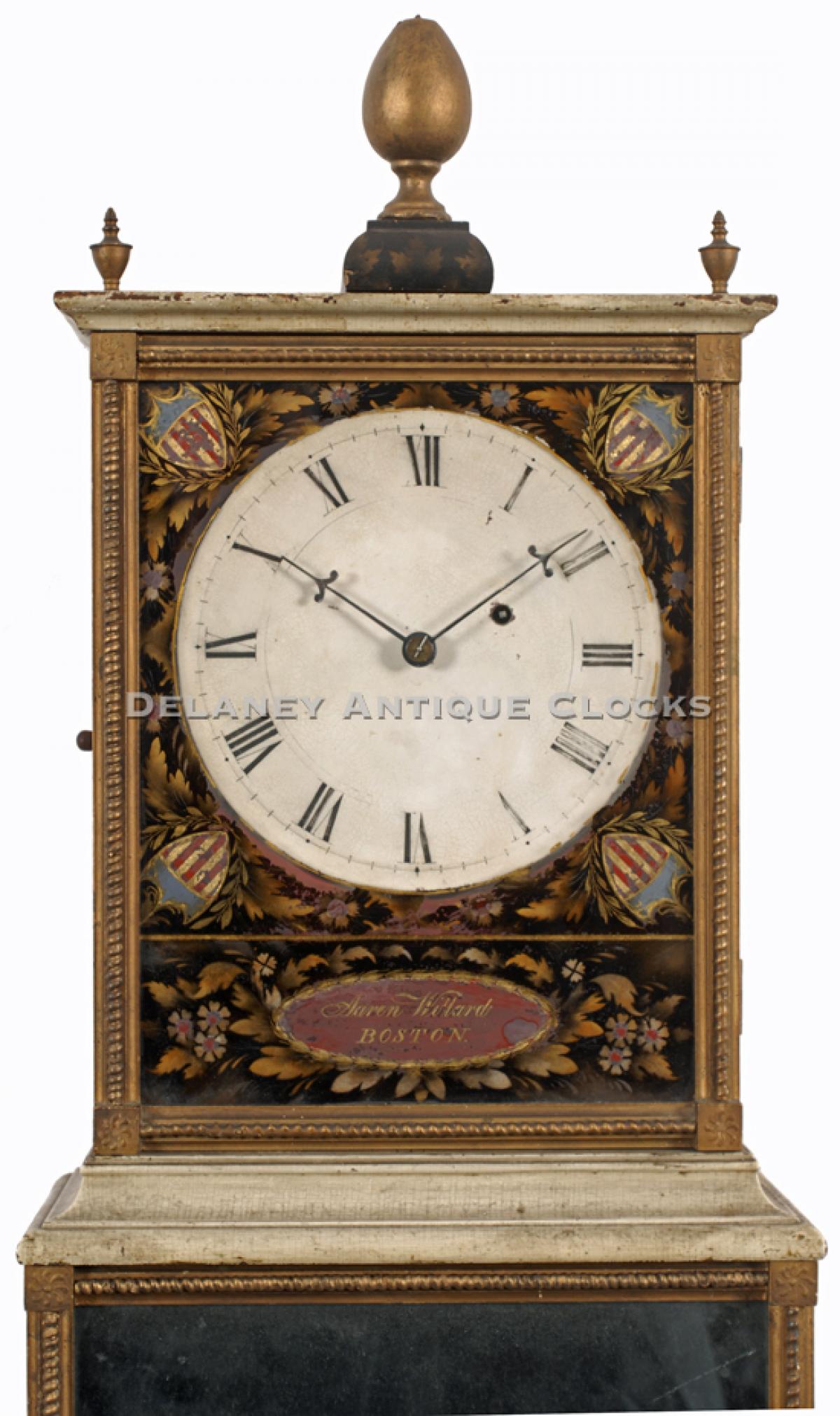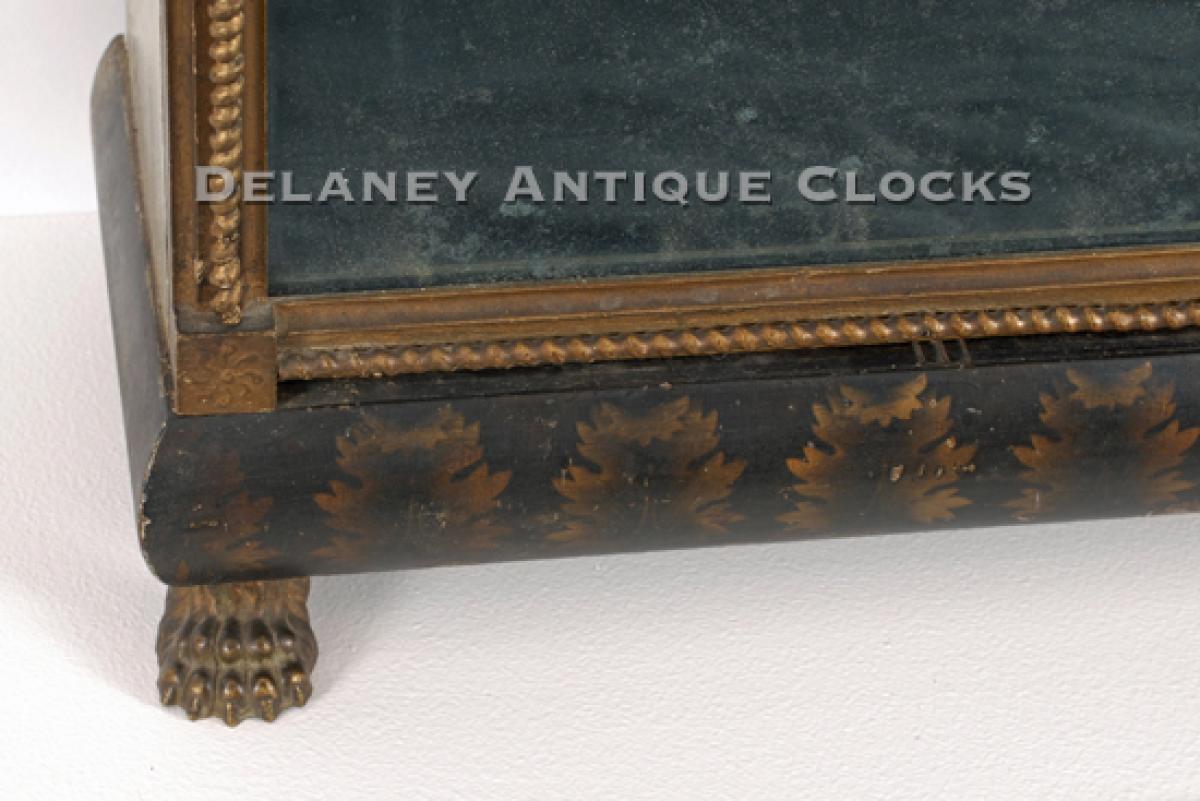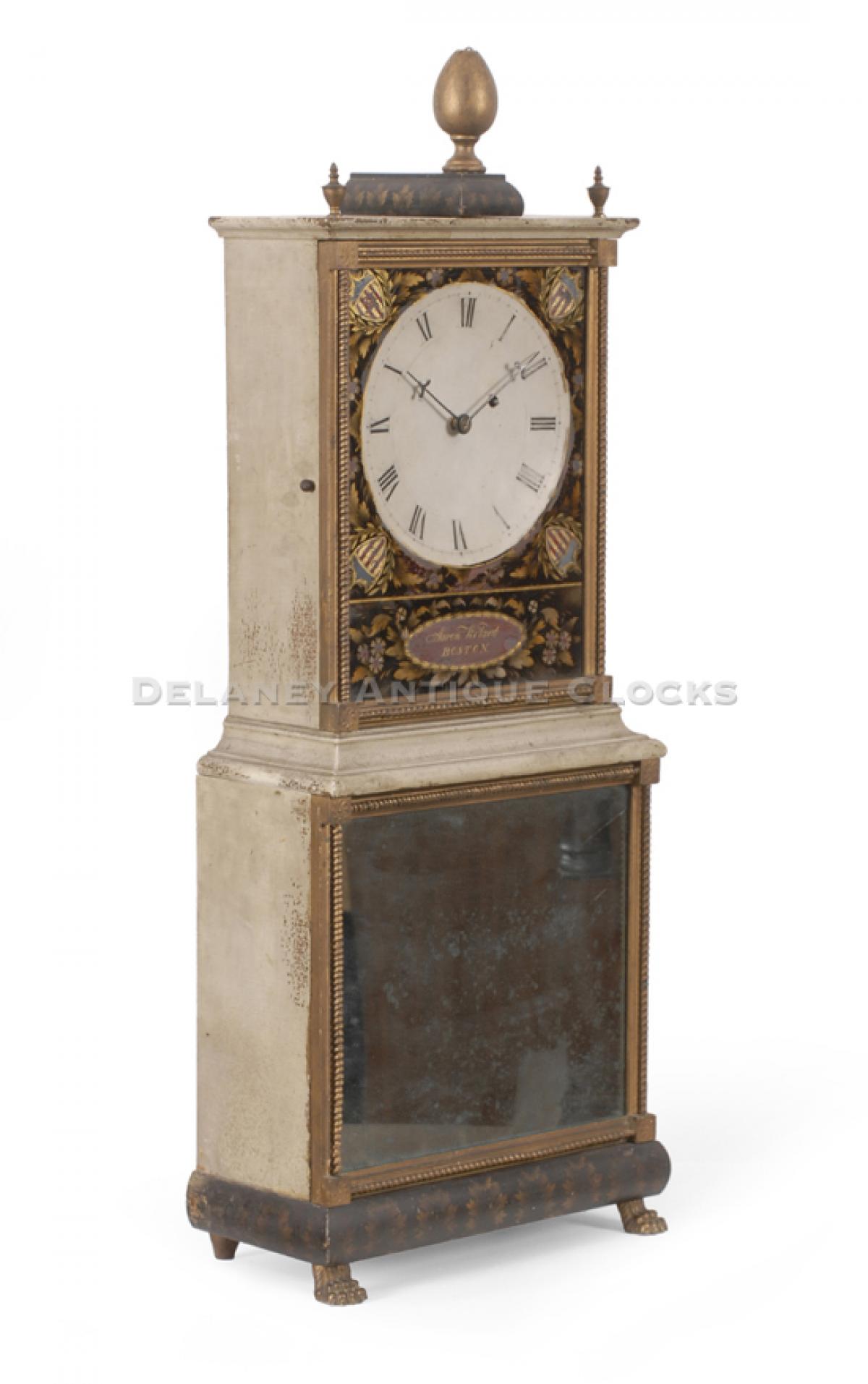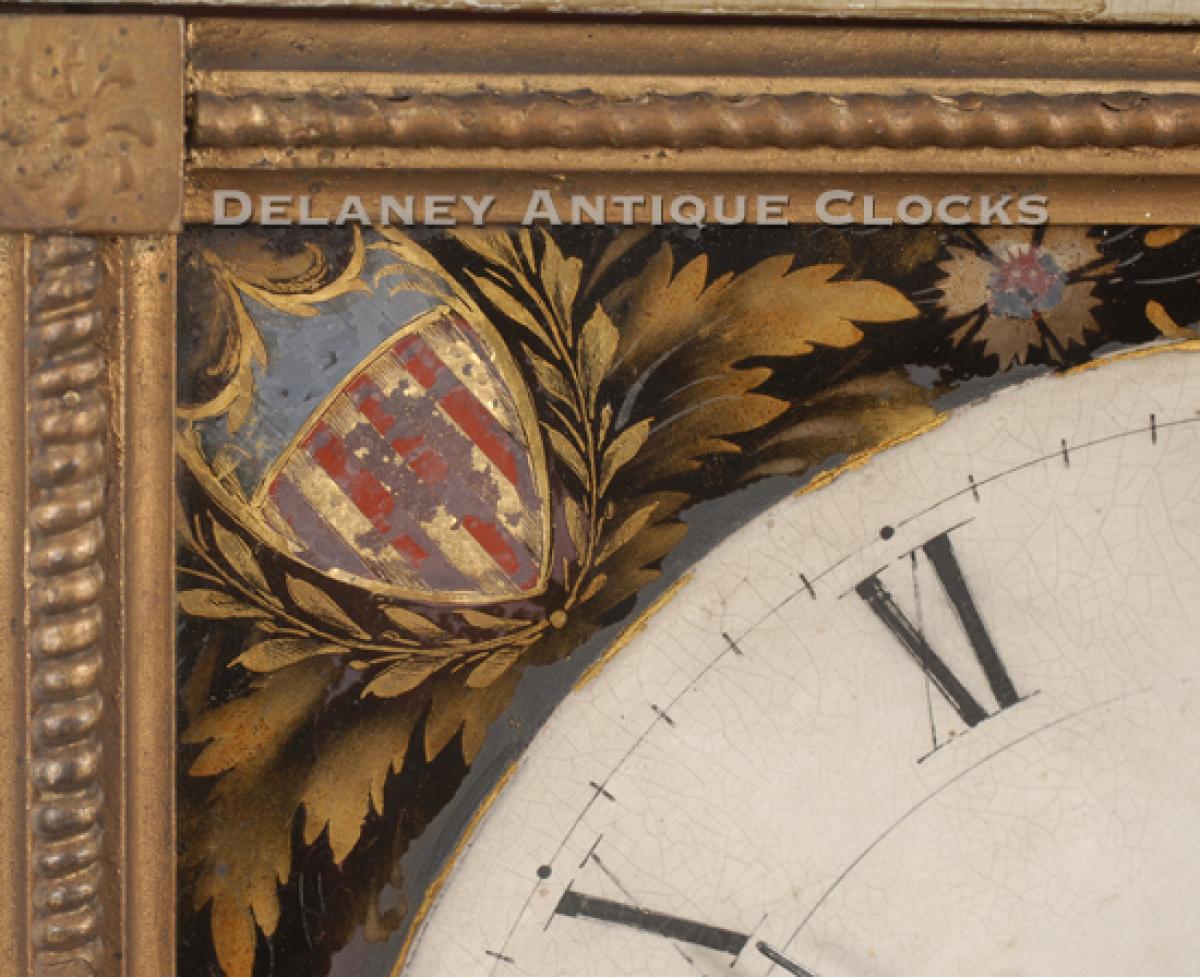Aaron Willard Boston, Massachusetts. "Brides Model" Massachusetts shelf clock. XXSL-8.
This is a rare and very important Brides Model cased Massachusetts Shelf Clock was made by Aaron Willard of Boston, Massachusetts.
The case is constructed in cherry and retains its original white painted surfaces. The outward-facing surfaces of the case were originally painted white to signify purity. This was considered an appropriate gift to a newly married bride. We know that these clocks were very expensive in their day. A bill of sale dated February 27, 1823, exists from the shop of Gridley & Blake. This firm was located at 27 Cornhill, Boston. It lists the cost of a similar clock at $25.00. The same bill also lists a Pembroke table valued at $7.50 and a rocking chair at $2.75.
This clock stands on nicely formed animal paw/claw brass feet. They are applied to the underside of the case and elevate the stencil-decorated molding found at the bottom of the case. The base section features a gilt frame fitted with twisted rope molding. This framing detail is repeated in the upper section of the case and forms an access door. The lower panel centers on a mercurial mirror. The upper door is fitted with eglomise glass that features American shields in each of the four corners. The dial door features an additional section where the Maker’s name and working location are prominently displayed. It reads, “Aaron Willard / BOSTON.” The hood or bonnet is surmounted with a shaped wooden plinth that supports the gilt acorn finial. Two brass finials are mounted on the outside edges. The painted iron dial is concave and measures approximately 8 inches in diameter. It features a closed time ring that marks the hours with Roman numerals. The hands are of very high craftsmanship in that they are hand filed. The cross-speared design has a wonderful three-dimensional quality. The movement is constructed with cast brass plates and wheels. The pinions are steel. The escapement is a recoil format. The movement is a time-only design and is powered by a weight. The movement is designed to run for eight days on a full wind. This clock was made circa 1820 and stands approximately 33 inches tall.
Inventory number XXSL-8.
Aaron Willard was born in Grafton, Massachusetts, on October 13, 1757. Little is currently known of Aaron's early life in Grafton. His parents, Benjamin Willard (1716-1775) and Sarah (Brooks) Willard (1717-1775) of Grafton had eleven children. Aaron was one of four brothers that trained as a clockmaker. In Grafton, he first learned the skills of clock-making from his older brothers Benjamin and Simon. It is recorded that Aaron marched with them in response to the Lexington Alarm on April 19, 1775, as a private under Captain Aaron Kimball's Company of Colonel Artemus Ward's Regiment. Aaron re-enlisted on April 26 and was soon sent by General George Washington as a spy to Nova Scotia in November. By this time, he had reached the grade of Captain. He soon returned to Grafton to train as a clockmaker. In 1780, Aaron moved from Grafton to Washington Street in Roxbury along with his brother Simon. Here the two Willards establish a reputation for themselves as fine clock manufacturers. They were both responsible for training a large number of apprentices. Many of these became famous clockmakers in their own right. The Willards dominated the clock-making industry in the Boston area during the first half of the nineteenth century. Aaron worked in a separate location in Roxbury from his brother and, in 1792, relocated about a quarter-mile away from Simon's shop across the Boston line. Aaron is listed in the 1798 Boston directory as a clockmaker "on the Neck," His large shop employed up to 30 people, while 21 other clockmakers, cabinetmakers, dial and ornamental painters, and gilders worked within a quarter-mile radius by 1807.
Some important dates for Aaron Willard include...
1783, Aaron married Catherine Gates. They have two children. The first is Aaron Willard Jr who becomes a very accomplished clockmaker. Catherine Gates dies in 1785.
1789, Aaron marries Polly Patridge. Polly has two sisters that also marry clockmakers Abel Hutchins and Elnathan Taber. Aaron and Polly have nine children. Two work-in-the-clock trades. George Willard 1817-1821 becomes a journeyman clockmaker. Henry Willard (1822-1887) trained as a cabinetmaker and made cases for the Willard operation when he came of age.
1792, Aaron builds a large home at 143 Washington Street in Boston. He lives in this house until he dies. This house is also the location of his workshop. A barn is converted into an area to finish wood. Other spaces in the carriage shop are rented to related artisans.
1802-1804, Aaron is in a business partnership with cabinetmaker James Blake as Willard & Blake. Aaron's position is financial.
1804, Aaron he transforms the carriage house and barn into a workshop space for artists, clockmakers, woodworkers, etc. It is now known as Willard's Compound.
1805-1806, Aaron is a financial backer in the partnership of Willard & Nolen. Spencer Nolen (1784-1849) is an ornamental artist who begins painting clock dials. In 1808, Spencer Nolen married Aaron Willard's daughter.
1823, Aaron Willard retires. He is 66 years old.
1844, Aaron died on May 20 and is buried in the Eustis Cemetery in Roxbury.
We have owned a large number of tall case clocks made by this important Maker. In addition, we have also owned a good number of wall timepieces, some in the form of banjo clocks, gallery clocks, as well as numerous Massachusetts shelf clock forms.



